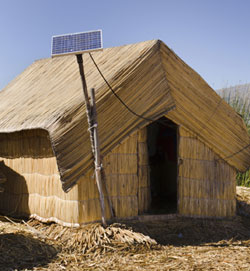Peru, the third largest country in South America, has launched a national program that will bring solar to two million of its poorest citizens, while encouraging the growth of small, homegrown solar businesses.
Under the National Photovoltaic Household Electrification Program, 12,500 solar PV systems will be installed, supplying 500,000 homes – 2 million people – with electricity for the first time at a cost of $200 million.
1600 solar panels have already been installed in Contumaza province, where they are powering 126 communities. The government paid for this first tranche and private contractors are bidding to install the rest.
The goal is to bring electricity to 95% of Peru’s citizens by the end of 2016, from 66% today.

"This program is aimed at the poorest people, those who lack access to electric lighting and still use oil lamps, spending their own resources to pay for fuels that harm their health," says Energy and Mining Minister Jorge Merino.
The project will also "demonstrate the viability of establishing micro enterprises to sell, maintain and operate PV systems, as well as creating incentives for increased public and private sector investment in photovoltaic-based rural electrification."
By the time this project ends, Peru’s PV industry will have grown installing 1000-2000, 50-watt systems a year to nearly 7000 systems a year. Doing so is expected to cut the cost from $713 to $513 for a system.
Nearly half of Peru’s 24 million citizens live in poverty, 19% living in extreme conditions. 1.6 million people have no electricity at all. They use candles, kerosene torches and wood stoves, which cost about $77 a year. Bringing solar to 2 million people is 10% of the population.
The biggest solar projects in Latin America are in Peru, two 22 megawatt plants developed by Spain-based T-Solar Global. There’s certainly plenty of sun.
Of course, solar isn’t the only energy source Peru plans to expand. As the world’s second largest copper exporter, the mining industry needs more electricity. The country plans to add 2.1 gigawatts of capacity over the next few years – the plan is 300 MW of renewable energy and the rest from big hydro and gas-diesel plants.
The controversial mining sector, the target of increasing protests, is gobbling up energy, draining rivers and pristine lakes, leaving indigenous people without water. The enormous mines scar the landscape.
